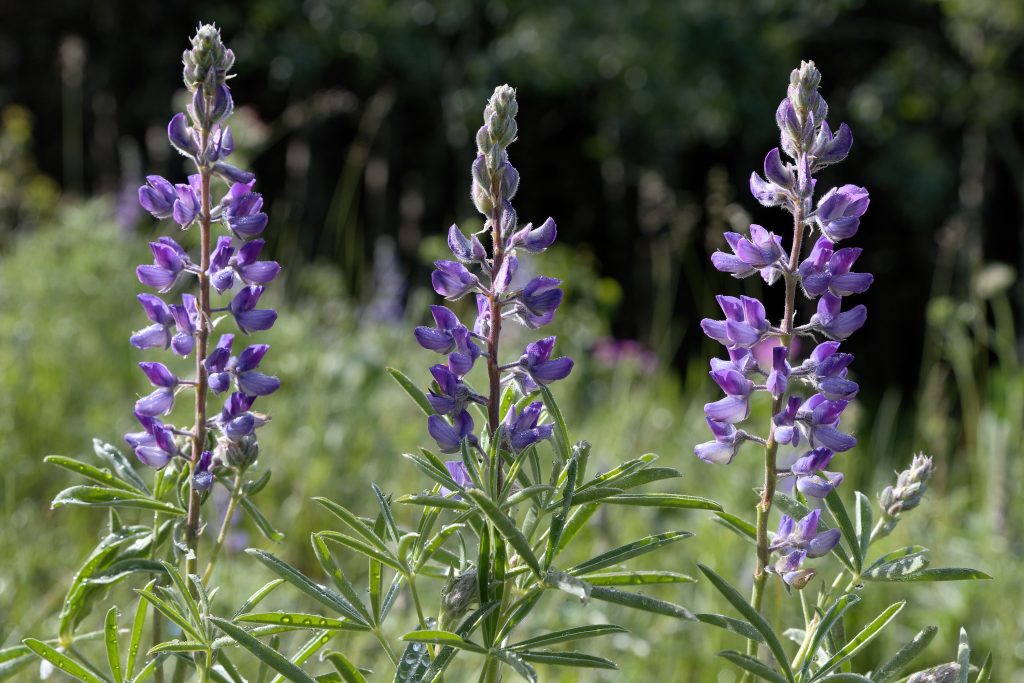Survival Against the Odds: Alberta’s Half-moon Hairstreak Butterfly
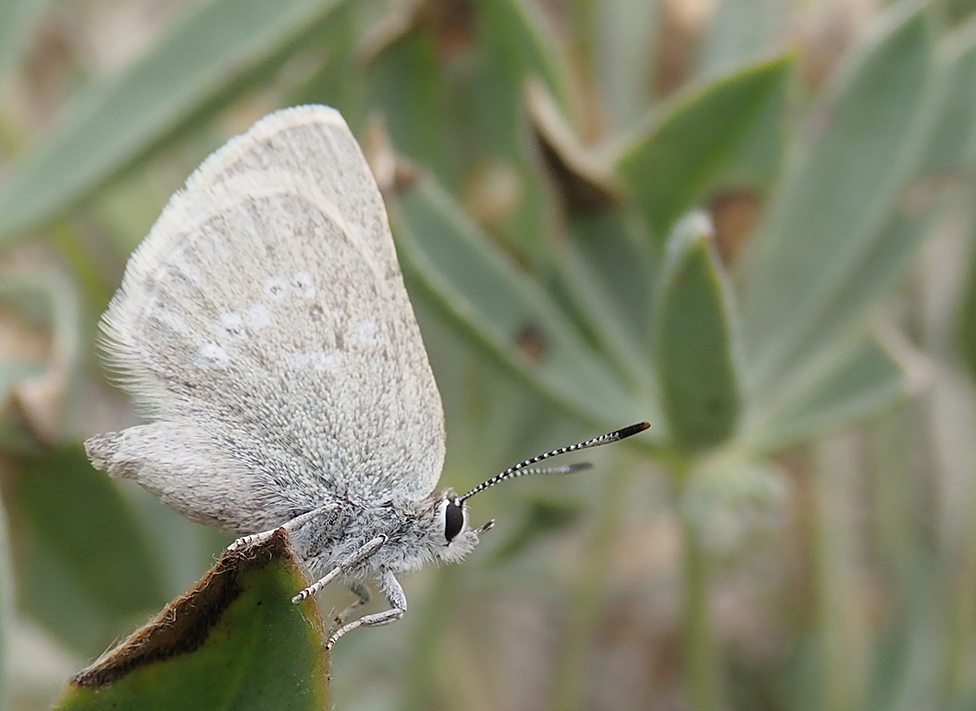
A half-moon hairstreak at rest on a silvery lupine, now long past flowering. BENNY ACORN
BY BENNY ACORN
Picture a vast mountain meadow still caught deep in the icy talons of the late winter months. The small streams that bisect the area are just beginning to flow with meltwater. Sparse trees rim the meadow, bare and skeletal because of the winter cold, with some still bearing the soot-stains of recent wildfire. Towering mountains decorated by glittering snow surround the meadow on all sides except to the north, where the alpine gives way to the endless skies of southern Alberta prairie.
This breathtaking scene is the Blakiston Fan, an alluvial plain in Waterton Lakes National Park. It is truly one of the most beautiful and remarkable areas in all of Alberta, where natural beauty is partnered with rich and unique biological diversity. Although you would not expect it, the story of one of Alberta’s rarest insects begins here, under the late-winter snow. This is a story of unexpected alliances, remarkable specialization, and perseverance in the face of catastrophic adversity, and it all takes place on the Blakiston Fan.
An Alberta Rarity
Mountain species often have highly specialized habitat requirements, and this is especially true for Alberta’s endangered half-moon hairstreak butterfly (Satyrium semiluna). Found in Alberta only in the Blakiston Fan, these butterflies begin life as pale green eggs laid at the woody base of a very particular group of plants: the lupines. As winter turns to spring, and wildflowers populate the Blakiston Fan, hairstreak caterpillars feast on the sugar-rich new plant growth.
Naturally, life is not all milk and honey for the young hairstreak caterpillars. Their sugary diet and soft exoskeleton make them an easy, tantalizing meal for all manner of predators. But these perils don’t faze our intrepid little butterfly because it hires the best group of bodyguards in the business: ants! Although ants may not seem that fierce to us, they are some of the toughest movers and shakers of the insect world.
Several ant species build their nests among the roots of lupines, where they serve as the steadfast defenders of hairstreak caterpillars against all manner of threats. This is an example of myrmecophily, a mutually beneficial relationship between ants and other organisms. Myrmecophily is not uncommon in the butterfly family the half-moon hairstreak belongs to. As their contribution, hairstreak caterpillars secrete surplus sugars and nutrients from specialized glands. The mutualistic ant species simply cannot get enough of this sugary soup and guard the juvenile hairstreaks, like humans tend livestock, for the duration of their larval development.
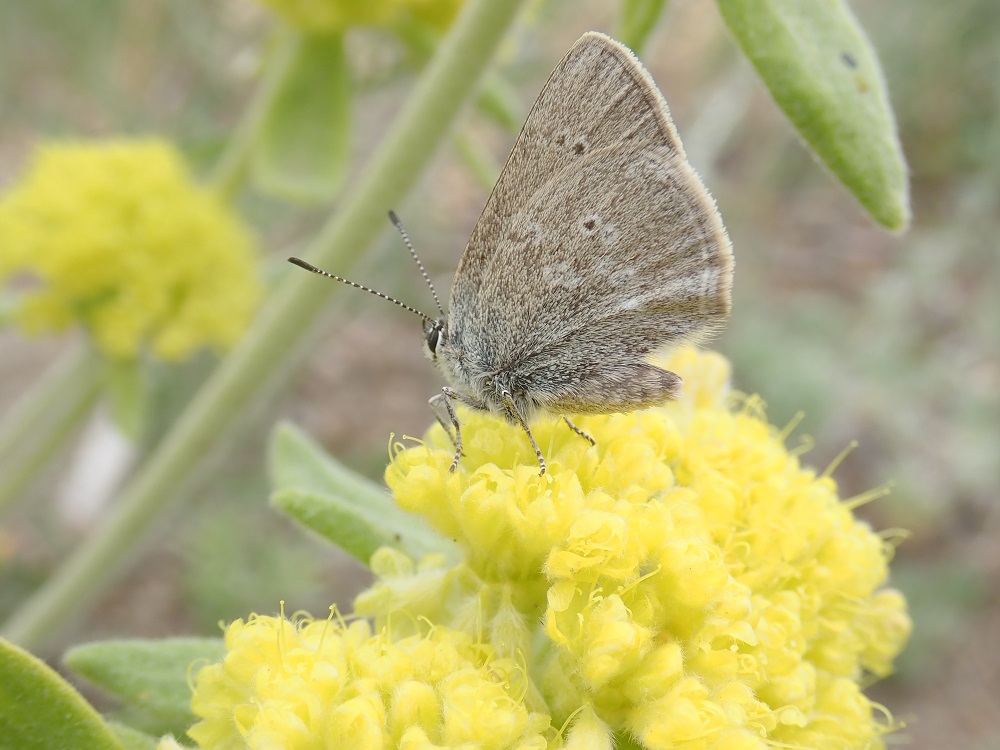
A female half-moon hairstreak perched on her favourite kind of flower, yellow buckwheat. BENNY ACORN
As the windy Waterton spring gives way to the sweltering heat of summer, the hairstreak larvae, now double in size, enter into their chrysalises around the roots of the lupine. A few weeks later the hairstreaks emerge as adult butterflies. With muted monochrome hues of brown-grey and almost no discernible markings, the nickel-sized half-moon hairstreak is perhaps the least visually interesting butterfly in the province, although it does retain an almost teddy-bear appeal in fuzzy brown cuteness.
Adult hairstreaks only live for about two weeks, considerably less than the nearly year-long period they spend in egg and juvenile form. During this time, they will feed on the nectar of buckwheat and goldenrod, helping to pollinate these plants. In this short span the butterflies will also mate and the females will select a lupine upon which to lay their eggs. At this point our story begins anew. Or it would, except that nature is often not so simple.
Our Hero Faces Disaster
In September 2017, the half-moon hairstreak faced a catastrophe. Wildfire raged through nearly half of Waterton Lakes National Park, and the Blakiston Fan was not spared. The fire’s impact was still clearly visible to me as I worked there in the summer of 2022, five years after the fire swept the field bare. The mountains that surrounded me were almost completely stripped of trees, creating stark and skeletal scenery. Within the fan, there were large areas where only two or three trees still stood. It will be many decades yet before the park resembles the Waterton I remember from my younger years, though to be truthful, I find the harsh beauty of this time of new growth just as enchanting.
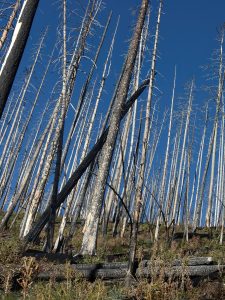
Evidence of the 2017 wildfire is still visible in many parts of Waterton Lakes National Park. R. SCHNEIDER
Wildfires play a vital role in maintaining the meadow habitat required by the hairstreak and many other species. However, because Waterton’s hairstreak population was small and crammed into a relatively small area, the fire posed a serious threat to its viability. In the years following the fire, Parks Canada surveys yielded observations in the single digits over the butterfly’s entire flight period. For a species usually numbering in the hundreds or thousands, even in a small habitat such as the Blakiston Fan, things were looking grim. Much of the plant life the hairstreak relies on was destroyed by the fire and hairstreak population numbers were at an all-time low. This is what motivated the research and conservation project I was a part of in the summer of 2022, in which Parks Canada partnered with the Wilder Institute/Calgary Zoo to investigate this enigmatic butterfly and search for conservation solutions.
Fortunately, the challenges faced by the hairstreak were temporary. The lupines on which the hero of our story relies were quick to recolonize their habitat, once again establishing a nutritious resource across the Blakiston Fan for both hairstreak caterpillars and their ant protectors. The population of hairstreaks began to grow once again, and a modest but noticeable cloud of hairstreaks returned to decorate the flowers of buckwheat in the last weeks of July.
The Deadly and Dangerous World of Flowering Plants
There is yet one other chapter to the hairstreak’s story that merits telling. The lupines were not the only plants eager to capitalize on the aftermath of the 2017 fire, and unfortunately for the hairstreak, the competition was stiff. You may be surprised to know that the world of wildflowers is actually quite cutthroat. Establishing the space needed to thrive and reproduce is a matter of life and death for plants. The plants best suited to conquer disturbed areas, such as recently burned sites, are often plants with invasive tendencies.
On the Blakiston Fan, an invasive plant emerged that met those qualifications handily — a merciless conqueror whose goal is naught but total domination: spotted knapweed. Spotted knapweed is a non-native plant in the aster family, a group that includes many wildflower species well adapted to early post-disturbance landscapes.
Spotted knapweed produces incredible numbers of wind-dispersed seeds that establish quickly, facilitating its entry to new areas. In addition, it’s able to inhibit the growth of other plant species, a particularly problematic trait. As the knapweed matures, it releases poisonous compounds into the soil, altering the ground chemistry in ways that prevent the establishment of other species. After only a few years, large swaths of the Blakiston Fan were reduced to a near monoculture of knapweed, with only a small selection of native plants able to eke out a living amongst the forest of the dreaded conqueror. (Also worth noting is the ability of dried knapweed stems to worm their way into one’s socks and boot linings, but that is one issue that the hairstreak thankfully does not have to contend with.)
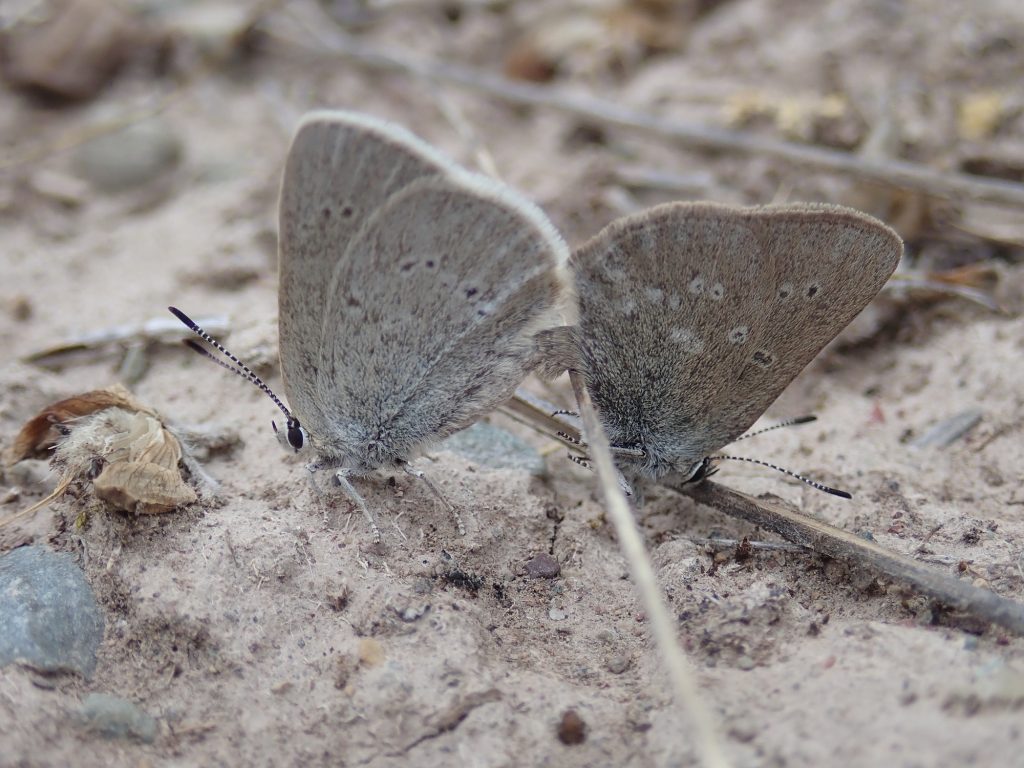
The tenderness of butterfly romance is on display as these coupling hairstreaks prepare to lay their eggs. BENNY ACORN
The Article Ends, but the Story Continues
The story of this butterfly is remarkable, but by no means unique in the world of insects. Our province is full of fascinating interactions just as complex as this one, but sadly, similar stories of habitats and species at risk are also far too plentiful. Fortunately, there are steps we can take to provide support. Parks Canada has been working with the Wilder Institute/Calgary Zoo to investigate the ecology of the hairstreak and test a variety of weed-removal strategies for combating spotted knapweed. If you have the opportunity to visit Waterton Lakes National Park (and you should, the park is truly stunning!) or any other protected area, avoid stepping on wildflowers and ensure you’re cleaning footwear between sites to avoid transfer of invasive plant seeds. Even if you never set foot on the Blakiston Fan, you can support local conservation organizations that work to protect the half-moon hairstreak and other species. Simply being aware of the amazing stories of the insect world and helping to share them by reading this publication is meaningful; the first step to conserve is always to care about the subject of conservation.
The half-moon hairstreak really is one of my favourites among all Alberta insects, and perhaps it will become one of yours. To me, its story is that of an unassuming underdog who manages to triumph over adversity by virtue of ingenuity and choosing the right allies to rely upon; an entomological Frodo Baggins. Yet it is also the sort of story that happens right under our noses all the time; such is the dramatic world of entomology. If you take anything away from this story, I hope it is that fascination with the natural world can be found in even the most unassuming creatures. Alberta’s rarest butterfly has flourished because it has chosen its friends wisely, but in the face of such odds as the half-moon hairstreak now faces, they can use all the friends they can get.
More Information
Environment and Climate Change Canada (2016). Recovery Strategy for the half-moon
hairstreak (Satyrium semiluna) in Canada. Species at Risk Act Recovery Strategy
Series. Environment and Climate Change Canada, Ottawa. 2 parts, pp. 24 and 33.
Crown of the Continent Research Learning Center (2022). The half-moon hairstreak Butterfly Recovery Project in Waterton Lakes National Park [Video]. YouTube. https://www.youtube.com/watch?v=by6kiTrRZzQ
Benny Acorn is one of the directors of the Alberta Lepidopterists' Guild and a lifelong lover of insects. Passionate about butterflies in particular, he has worked with the Wilder Institute/Calgary Zoo to help research and protect the endangered half-moon hairstreak butterfly.
This article originally ran in Nature Alberta Magazine – Fall 2023.

